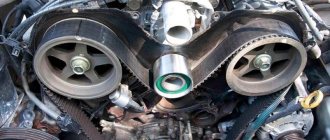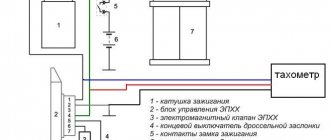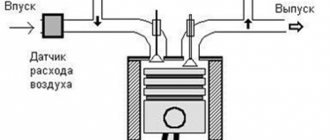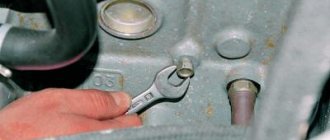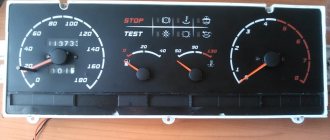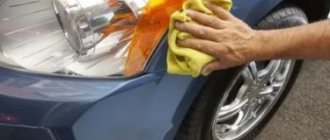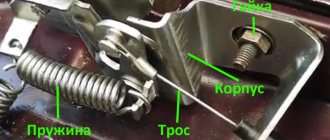How to properly grind valves using the example of a VAZ 2109
Valve lapping - why is it necessary?
The main task of the lapping procedure is to organize the correct functioning of the valves.
If grinding is ignored on an ongoing basis, then you cannot count on high-quality operation of the valves. Air and fuel will not be introduced into the cylinders quite correctly, but the consequences of this discrepancy will not be long in coming: the engine will begin to malfunction, and after a certain period of time, it is very likely that the engine will please you with a banal failure. By grinding in the valves, the maximum possible sealing of the mechanism is achieved. The valves are ground in both after the introduction of new elements and during prolonged operation of the power unit. As an example, you can take the jerking of a car at idle, which occurs due to a difference in compression. After grinding in, such a misunderstanding should inevitably disappear.
How to determine if the valve is tightly seated on the seat?
If you have removed the head, be sure to pay attention to the valves; at first glance, it may seem that the valves are good, but there is one sure sign that the valve definitely needs to be changed or ground in. Valves can be of different colors, white, brown, black, etc. This is normal, it all depends on the carburetor settings and engine oil consumption. But if the valve has different shades as shown in the photo below, this is a sure sign that the valve is poorly ground to the seat. This valve must be ground in or replaced with a new one, but it must be ground in.
Photo. Valve showing signs of burnout.
The valve in the photo can still be ground in, but if there is a blue tint, it is better to replace such a valve with a new one.
Spare parts and tools for work
Before starting work on replacing valves on a VAZ 2110, high-quality new parts are purchased, the names and original articles of which are as follows:
- Set of gaskets: valve cover (art. 2108-1003270/77) and cylinder head (art. 21083-1003020), intake and exhaust manifolds (set art. 21083-1008081), exhaust gas intake pipe (art. 2103-1203020-04) , as well as an oil seal (art. 2108-1005034) and oil flinger rings (art. 2108-1007026-86) (the so-called cylinder head repair kit)
- New valves for the fuel mixture intake system 4 pcs. (art. 21083-1007010)
- New exhaust system valves 4 pcs. (art. 2108-1007012)
- Valve guides 8 pcs. (art. 2108-1007032-87)
- Engine coolant
- New bolts securing the cylinder head to the cylinder block (art. 2108-1003271Н/О)
- Timing belt (art. 2108-1006040-86) and generator drive belt (art. 1000012562)
- Engine oil and oil filter
Repairs to replace worn-out parts are carried out using a standard set of tools, which are usually sold as a set, namely:
- a set of open-end wrenches marked from 8 to 21 mm;
- set of internal hex keys;
- a set of sockets with a diameter from 8 to 24 mm;
- valve desiccant;
- screw valve guide puller;
- torque wrench (needed for proper tightening of the camshaft, cylinder head and camshaft gear bolts);
- Screwdriver Set;
- electric drill;
- specialized lapping paste of two types (for rough lapping of valves to their working surface of the combustion chamber and for finishing grinding);
- gloves to protect hands from possible damage.
The presence of tools, parts and a covered room will allow you to carry out troubleshooting work yourself, since the price of replacing 8 valves on a VAZ 2110 in non-certified services in the fall of 2021 varies from 30 to 45 thousand rubles. At a certified service station of official dealers, such work will cost more than 50 thousand, which will greatly affect the financial situation of the car owner.
Features of valve adjustment
For the VAZ 2109, some changes were made to the engine design after 2011. The timing chain drive was reliable, but excessively noisy; chain tension required frequent adjustment. The problem with the camshaft belt drive was its insufficient resource.
The issue was resolved, the upper part of the piston was modified, and seat recesses were added for the heads. As a result of the use of new materials (cermets), the clearances were changed and the pistons became lighter. However, they still wear out and the valves need to be adjusted every 30,000 km.
So, when adjusting the valves on the VAZ 2109, we must take into account this difference in engines of different years of production
On modern ones, when installing the cylinder block with maximum pedantry and accuracy, it is important to align the camshaft with the crankshaft; they should not rotate separately. In addition, the thermal gaps of the “lightweight”, modern model are slightly larger
Important! A new car will need adjustment after 3,000 km. Before the next car will travel 15,000 km, only then this operation is carried out after a run of 30,000 km
This scheme is associated with the speed of grinding in and depreciation of factory parts of the mechanism.
When rotating, the camshaft presses the cams onto the washers at the ends of the valve stem. The force is transmitted to the caps, which must be hermetically ground to the saddles. During normal operation, the valve closes completely, preventing excessive fuel consumption, but maintaining the required power.
Over time, the initial efficiency decreases due to abrasion, destruction, including under the influence of thermal expansion, of the metal valve stem and subsidence of the seats. The cams wear out. The gaps are increasing.
Due to the loss of tightness of the connection between the cap and the seat, both filling the cylinder with fuel and the exit of exhaust gases are difficult. Too small a gap is also a problem, since the inability of the pusher to completely close the cylinder causes a drop in pressure, and the valve eventually burns out.
If you neglect the procedure for carrying out technical work, repairs will not be cheap, valves will burn out, seats will sag. In this case, restoration of engine functions is not guaranteed. In addition, if the thermal clearances are not adjusted, the thrust drops and fuel consumption increases.
Problematic seals
In addition to adjusting the valves, it is extremely important to check the current condition of the seals.
Valve seals are designed to prevent excess engine oil from leaking through. In ideal operating condition, they seal tightly against the valve and allow only the amount of oil to flow through to provide effective lubrication.
Valve seals
They sometimes have to be changed, since the rubber used to make oil seals ages over time and loses its elasticity. As a result, the oil seal leaks more oil than required. Engine oil consumption increases, problems arise in the lubrication system and more.
Therefore, we offer you instructions on how to replace them.
- The work begins with the obligatory removal of the negative terminal from the battery.
- Disconnect the contacts from the ignition coil and move them aside. It is better not to unscrew the spark plugs, otherwise you risk providing the cylinders with an impressive amount of dirt during the repair process.
- Disconnect a pair of rubber tubes from the valve cover. Loosen the valve cover mounting screws and unscrew them. Subsequently, put all small parts, nuts, bolts in a separate jar so as not to lose anything.
- Remove the valve cover and a pair of gaskets. It is best to replace these gaskets immediately.
- In order not to remove the cylinder head side cover, which covers the camshaft chain and sprockets, you can move the sprockets into the cover as far as it will go and remove the shafts from them.
- Remove the spark plugs. First, insert the oil dipstick into the spark plug hole until the end touches the piston. After this, carefully rotate the pulley until the dipstick stops before lowering.
- Using a marker or paint, make marks on the sprockets and chain, fixing the required position of the teeth in the chain. This way, when reassembling, you will be able to correctly return the chain to the teeth on which it was located before dismantling.
- Unscrew the sprockets using an open-end or socket wrench. To prevent the cylinders from turning, secure the large pulley below the wheel with a key.
- Remove the shaft mounting yokes. The one next to the stars is removed first. Next, all the others are removed, adhering to the order of weakening. Place all the elements on a rag in the order in which you removed them. This way you won't get confused when reassembling.
Replacement procedure
- Remove the stars from their nests. The first one is easily removed in the area of the cylinder head side cover, if you remove the shaft position sensor first. It is held on by one bolt, so there should be no problems here.
- Having freed the shafts from the yokes, lift them a little using a flat-head screwdriver, and then remove them from the sprockets.
- After removing the shafts, remove the near sprocket and secure the chain with a slight tension.
- Next, the valve cups are dismantled. They are shiny, so it is difficult to confuse them. Although no cup holders are used, removing them can be a problem. They stick from the inside. Try using a powerful magnet.
- Remove the springs. To do this, you will need to loosen the valves on cylinders 1 and 4. This is due to the fact that on them the piston is at TDC. Secure the outer bracket with a bolt using a suitable hole in the block head. Using the second bracket, jerk the washer until it stops. The crackers should come free, after which you carefully remove them from their seats with a magnetized screwdriver.
- Remove the springs along with the washer. Place them on the table in the order in which you removed them. That's it, we finally got to our oil seals.
- Use pliers to remove the old seals. This can take quite a long time.
- Put on new oil seals, treating them with engine oil first.
- Press into place using a washer or tube of the required diameter.
- Put the springs back in place and dry them. Here you need to be as careful and attentive as possible. We recommend covering the engine with a rag. Having dried the valves of cylinders 1 and 4, move the pistons of cylinders 2 and 3 to TDC, then repeat the operation.
- Having dried the last valve, proceed to reassemble the unit. Here, strictly follow the reverse sequence.
How to drive a valve guide into a head
First you need to choose a valve bushing before hammering it in, there is a large selection of valve bushings in stores, ask the seller for factory guide bushings, and naturally he will answer yes (he needs to sell it and the sellers know how to hang noodles). And then you get a headache, the bushing is clogged and the valve won’t fit, but for this the mechanic has a special rubber that you don’t have. I’ll explain how to distinguish a high-quality valve bushing from the left (underground) ones. Take the valve with you and when buying valve bushings, try to put it on the valve, the factory bushing will fit easily and will move freely along the valve and the outer wall of the bushing will be polished to a shine, and the place where it is stuffed The valve seal will be matte in color. The left valve sleeve will not fit onto the valve or will fit tightly and its color will be completely dull. The valve sleeve should fit easily onto the valve, since when it is hammered into the head, it is slightly compressed and the valve fits in as it should.
Before hammering the valve sleeve into the head, put a retaining ring on it, remove it from the old sleeve, lubricate the hole in the valve head where you will drive the sleeve, the sleeve is driven from top to bottom until the retaining ring (do not overdo it.).
Zhiguli valve bushings must be driven in carefully, do not hit the place where the valve seal is packed, this place is very fragile, find a tube with an internal diameter of 12 and maximum 13 mm, place it on the bushing so that the place where the seal is packed is inside the tube, and also carefully hammer it into the head with a sledgehammer. Drive the valve bushings onto the head of the UAZ or Gaza in such a way that on the edge on which you will hit, place a piece of tin or a thin piece of wood, place a bolt or round timber with which you knocked it out, and also hammer it into the head with a sledgehammer
If you suddenly accidentally slightly bend the edge of the bushing hole, you can level it with a drill or a file
Drive the valve bushings onto the head of the UAZ or GAZ in such a way that on the edge on which you will hit, place a piece of tin or a thin piece of wood, place a bolt or round timber with which you knocked it out, and also hammer it into the head with a sledgehammer. If you suddenly accidentally slightly bend the edge of the bushing hole, you can level it with a drill or a file.
The procedure for adjusting the thermal clearances of valves on VAZ 2109-21099
Attention! The car engine must be cold and its temperature at the time of adjustment should not be higher than 20 degrees.
Video tutorial on how to do the job
In order to clearly demonstrate the procedure for adjusting thermal gaps, it was decided to record a special video clip that shows everything in detail.
If from the guide presented above there is something still unclear to you, then below everything will be presented in a form familiar to everyone.
Photo report of the performed maintenance
So, before proceeding with this operation, you first need to remove the valve cover, as well as the casing under which the timing mechanism is located.
After this, you need to set the gas distribution mechanism according to the marks. To do this, jack up the front right part of the car so that you can turn the wheel by hand to set the valve timing marks.
Then we turn the wheel until the marks on the camshaft sprocket and the marks on the rear timing cover align, as clearly demonstrated in the picture below:
At the same time, make sure that the mark on the flywheel also coincides with the cutout. You need to look through the window, which is located to the right of the fourth cylinder on the gearbox housing. You must first remove the rubber plug:
When the camshaft is in this position, you can begin to measure the thermal clearances between the cams and pushers of the 1st, 2nd, 3rd and 5th valves (counting from the left):
For intake valves, the nominal clearance should be 0.20 (+-0.05) mm, and for exhaust valves 0.35 (+-0.05) mm. If you don’t know the location, I can say: from left to right in order: exhaust-inlet, inlet-outlet, etc.
If, when measuring the gaps, they go beyond the maximum permissible values, they must be adjusted by installing new shims. To do this, we put the bar on the valve cover studs and secure it with nuts.
Now we bring the mechanism lever to the desired valve, and direct it as if between the pusher and the camshaft cam, and recess the valve to the very end:
And when the pusher is pressed down as much as possible, you need to insert a clamp between the camshaft and the pusher:
It is worth noting that the cutout on the pushrod should be facing towards you so that you can conveniently remove the shim. It is very convenient to use long-nose pliers for this:
After that, look at its size, which is indicated on its back side:
Now we calculate, based on the measured gap and the thickness of the old washer, what the thickness of the new washer should be in order to achieve the optimal gap.
Now you can insert the new washer into place and make further adjustments. When the first 4 valves are ready, you can turn the crankshaft one revolution and carry out a similar procedure with the remaining 4, 6, 7 and 8 valves.
Good day. Tell me how to estimate the required thickness of the washer under the following conditions: after assembling the cylinder head in the garage, a mechanic and I were forced to cut off the thickness of the standard washer on the 1st and 3rd outlet valves to a gap of 030+005. Engine 21083 injector with a mileage of 170 t.km. The positions of the service technicians have changed to a worse position for the car enthusiast whose car is not a luxury. The latter are drawn to old-school craftsmen and production areas with mechanical processing of the cylinder head. The event of milling the surface of the cylinder head abutment to the block and replacing valves one or two valves with lapping creates a situation: at the mechanical processing area there is no equipment for adjusting the valve with the cylinder head dismantled. And during the assembly of the cylinder head into the engine, the assembly mechanic involuntarily cuts off standard washers for a large 030 -040 thermal gap on the repair valve in order to allow the car, under its own power, without damaging the same valve from a heated engine, to reach the point of adjusting the thermal clearance of the valves using washers.
one revolution is 360 degrees, the valves will return to their original position
No, they won't get up! One revolution of the crankshaft is only half a revolution of the camshaft!
So now I’m setting the gaps, first measured, do 1 revolution of the crankshaft and the shafts return to their original position, what the fuck
Egor, learn the material part or open the 9th grade Physics textbook and read FOUR STROKE internal combustion engines and you are talking about two-stroke engines. In short, like a peasant, when turning the crankshaft by 180 degrees, the mark on the camshaft gear is installed opposite the original one, but the gearbox does not match the gearbox and that’s all. In the initial position when the mark on the camshaft gear matches and in the gearbox hatch, adjust valves 1-3 and 2-5, and when turning 180 degrees, when the mark is opposite the original one but does not match, in the gearbox hatch you adjust 4-7 and 6-8
Methods and devices for grinding valves
Valves can be processed in different ways: manually or using machines. At the same time, you need to remember that the difference in the final result of these two methods will be significant. The most accurate work will be produced by a machine, but the lowest quality is attributed to manual work using a special lapping paste.
Machine tools
The machine provides rigid alignment, which allows you to make a verified mating, as well as cutting the chamfer of the valve and its seat. This procedure provides a high-quality result; all that remains is to rinse the block head and install it in place.
Hand cutters
If high-tech equipment is not available, a hand cutter comes to the rescue. Tools with the appropriate diameter are selected for a specific modification of the power unit. You can cut only 3 chamfers on saddles - 30, 45 and 60 degrees. Using this method, only old elements are processed.
Do-it-yourself lapping
In this case, an abrasive composition is used, and the procedure is carried out in cases where the surface simply needs to be processed without resorting to complex manipulations. This technique involves applying special paste around the entire circumference of the product, after which the spare part is installed in its place. Next, the valve is pressed against the seat and begins to rotate around its axis. Thanks to this maneuver, all plane errors are thoroughly erased. Upon completion of the maneuver, all paste is scrupulously washed off.
Lapping paste
A component of the process that deserves a separate topic is a special lapping paste, which can be either factory-made or homemade. It is worth noting right away that most home craftsmen give preference to branded compounds, especially since there is now a huge assortment on the market. Why were store-bought products among the favorites? There are two factors here: first, branded products are much more effective, second, many simply do not have the desire, time, skill, or components to produce a full-fledged product in their garage.
The purpose of the lapping compound is to effectively ensure contact between the valve disc and its seat. What exactly does a high-quality lapping paste provide:
- increasing the efficiency of the power unit;
- valve tightness increases to a high level - 90-100%;
- the engine curbs its “appetite” for oil;
- increasing the compression of the internal combustion engine.
Nuances
Grain size is one of the main indicators of lapping paste. The division is into coarse-grained and fine-grained. The purpose of the coarse-grained composition is to neutralize the largest defects, and the responsibilities of the fine-grained paste include the final stage of processing, when the smallest surface damage is eliminated. A completely natural conclusion follows from this: the greatest return from lapping will be if two paste options are purchased - coarse-grained and fine-grained. You should also follow the correct processing order: the coarse-grained paste is used first, and the fine-grained paste closes the process.
The nuances of proper valve grinding:
each valve is ground into its specific place, they can no longer be changed;
To carry out the grinding process, the cylinder head is removed. There are a few things to consider before you start:
- before removing the valves, the springs are removed, this makes it easier to remove them from the bushings;
- Before grinding the valves, they should be carefully examined. If they are defective, then they will need to be replaced with new products; if there is carbon deposits, then we deal with it using a metal brush.
When to change valve stem seals
Replacing the valve stem seals is necessary if:
- Engine oil consumption has increased, but no leakage is visible. This is the most deceptive sign, since most often the owners think that the problem is somewhere else and fill in the oil, not wanting expensive repairs.
- The engine consumes more than 1 liter per 1000 kilometers traveled.
- Smoke with a blue tint often comes out of the exhaust pipe.
- Motor oil appeared on the spark plug electrodes. This is a sign by which faulty valve stem seals can be accurately identified, since oil does not appear on the electrodes for other reasons.
Candles in oil
If at least one sign of the above is noticed, then replacement is already necessary.
Signs of valve failure
In addition to the established mileage, after which thermal clearances must be adjusted according to the rules, there are a number of reasons why the mechanism fails earlier.
Signals such as:
- the engine idles unstable, and the idle speed is not adjustable;
- dynamics deteriorate, power decreases;
- when pressed, the gas pedal “falls”;
- characteristic “popping” sounds in the carburetor.
The most accurate indication of an increase in thermal clearances will be rattling, knocking under the cover at idle. It is continuous and quite loud.
When the gap is reduced, there is no knocking, but the engine overheats and power decreases. Heavy acceleration, “shooting” at the muffler, all this indicates the need for unscheduled adjustments.
If it comes to burning out the valve, the motor will produce a distinct triple sound, in any mode. Power and fuel costs will also increase.
It is also important to distinguish the valve problem from other malfunctions that make themselves felt in a similar way. Options:
Options:
the pressure in the cylinders drops, but not due to a decrease in clearance or burnout of the valve, but due to wear of the piston rings;
spark plugs, wires - problems in this system also need to be ruled out in advance, especially since when adjusting you still have to unscrew the spark plugs, for convenience;
In an injection engine, fuel is supplied by injectors, which may be faulty; the system responsible for supplying fuel must be checked in advance.
Exclusion (or confirmation) of the presence of these breakdowns is carried out as follows:
- When the engine is idling, the protective cap is disconnected from the spark plug. The engine's reaction will show whether the reason is in the spark plugs/wiring, or in the valves, even specifically which cylinder is damaged. After the operation, the engine performance lost stability and worsened - the problem is not in the cylinder, the valves are intact. There are no changes in operation - the problem cylinder has been detected.
- If the nature of the failure is still doubtful, check the wiring, coil, and install a new, working spark plug on the supposedly faulty cylinder. Now the launch will definitely show whether the problem is in the ignition or not.
After ruling out a problem with the ignition system, if engine operation is still unstable, check the piston group.
- After measuring the compression, add a little engine oil to the cylinder. If the indicator does not change upon repeated measurement, we have a burnt-out valve; the indicator has increased - the problem is in the rings.
- Another sign is that if there are problems with the valves, there will be no oil or burning on the spark plugs, and there should be no smoke coming from the breather during operation. All of the above signs indicate a breakdown in the piston group.
After repairing the cylinder head, it is necessary to carry out an extraordinary adjustment. Also, more often than usual, they require regulation of the valves of cars converted to gas, since their mechanism is subject to constant overload. Frequent shock loads and careless driving also harm the gas distribution system, leading to the need for adjustments ahead of schedule.
How to make a replacement
Replacing oil seals in a VAZ 2109 engine is a relatively labor-intensive procedure that requires special skills and certain tools. It is advisable to carry it out in a garage or workshop. Allow enough time for work so as not to rush. Replacing oil seals in a VAZ 2109 engine requires care, precision, and attentiveness.
Prepare everything you need
Successful replacement of valve stem seals can be done with your own hands. But this will require more than just a simple set of keys. You will have to take care of preparing special devices. Before starting work, you must equip:
- tin (or soft metal) rod with a diameter of no more than 8 mm;
- desiccant;
- tweezers;
- hammer;
- set of keys, socket heads;
- pliers;
- collet (puller) for removing oil seals;
- flat screwdrivers;
- press-fit frame.
Step by Step Actions
You can change the valve seals by removing the cylinder head (cylinder head). Some experts claim that this is the only and most reliable way. However, in practice, most car enthusiasts ignore this belief and change oil seals without dismantling the cylinder head.
First, preparatory work is carried out:
- disconnect the negative terminal;
- remove the gear from the camshaft by carefully pulling out the key;
- by unscrewing the bolts located around the perimeter, dismantle the cylinder head cover (front);
- remove the back part of the cover (ignition distributor plug);
- remove the camshaft with oil seal.
- turn the crankshaft so that the piston under the cap being replaced reaches top dead center; having unscrewed the spark plug, insert a tin rod into the hole to prevent the valve from falling out;
- using a desiccant, the springs are removed from the valve;
- remove the crackers using tweezers;
- take out the upper spring plate, inner and outer valve springs;
- put the collet on the cap, dismantling it; craftsmen carry out this operation with pliers or screwdrivers;
- before installing a new cap, remove the spring from it;
- the prepared cap is dipped in engine oil and inserted into the mandrel;
- carefully press the cap until it rests on the bottom plate;
- return the spring from the cap to its place;
- the remaining valve seals are changed in the same way;
- replacement ends with the assembly of components and parts in the reverse order of removal;
- the rod is removed from the spark plug hole;
- after installing the crackers, substituting a metal rod, hit the valve ends with a hammer - the crackers are seated in place;
- when installing the camshaft, monitor the direction of the cams of the 1st cylinder - they should “look” in the direction opposite to the valve tappets;
- When reinstalling, all rubbing parts are lubricated with engine oil.
For better clarity, you can watch a video showing the replacement of valve seals in a VAZ engine. The demo video will present all the steps, after going through which you can change these important details yourself.
Let's start replacing the burnt out valve
Advice, do not remove the carburetor and manifold from the head, they do not interfere and you have less hassle with disassembling unnecessary parts. The first thing you need to do is dry out the valve, most likely you don’t have a valve puller, if you do, that’s great, but you can do without a valve puller. Place the head on a flat surface, preferably a strong table or wooden shield; you can also lay a rubber mat under it. Place any piece of iron under the valve that needs to be dry, the main thing is that the valve rests against it, take a tube with an internal diameter of 13 mm or more, the main thing is that it is no larger than the valve spring plate (for Zhiguli), for UAZ and GAZ the tube should be at least 16 mm. Place this tube on the valve so that the valve crackers are inside the tube, and hit the tube with a hammer, usually on the 3rd or 5th blow, the valve cracks and the crackers remain in the tube and are not lost, just press the tube tightly against the valve plate so that it does not jump off the valve plate upon impact . I’ll tell you right away, don’t be afraid, the spring won’t fly away and won’t hit your hand.
The valve is dry, pull it out, insert a new valve and shake it; if the runout is about a millimeter, then it is still tolerable, you can leave this valve guide, but if the valve dangles too much to the sides, it is advisable to replace the valve guide with a new one.
Sequencing
- There is a striker on the collet. You need to hit it accurately with a hammer. This will cause the cap to crumple and it will be possible to remove it from the collet with pliers.
The oil seal is removed from the guide bushing using a collet - Once the crackers are removed, the valve plate and its spring are removed.
When the spring is fixed, the valve nuts are removed using medical tweezers - After this, a tool is installed to decompress the valves and, with its help, the valve spring is pressed.
- After the piston reaches the dead center, the spark plug is unscrewed from the cylinder, and a tin rod with a diameter of 8 mm is inserted into the opened hole. The tip of the rod should be between the valve and the bottom of the piston.
- Now the crankshaft must be turned so that the piston in the cylinder where the caps are planned to be replaced reaches top dead center.
The camshaft is removed, then the oil seal is removed - First of all, you need to remove the wires from the battery.
- The timing belt is removed.
- The pulley with teeth is removed from the camshaft.
- The wires are removed from the first fastening, and the nuts are unscrewed from the third fastening.
- Four nuts are unscrewed from the front cover, then the nuts from the rear cover are unscrewed (there are six of them).
- Both covers are removed.
- The camshaft is removed.
- The oil seal is removed from the camshaft.
The valve spring is pressed firmly using a collet - After pressing the valve spring, the crackers can be removed using tweezers.
First, the valve plate is removed, and then the spring underneath it is removed. - Now, using a collet, you need to remove the oil seal from the guide sleeve.
By hitting the handle with a hammer, the cap is compressed in the collet and removed - The new cap is pressed into the valve plate, then a spring is installed on it.
- Similar operations are performed with all caps that need replacement.
- After replacement, the cylinder head is reassembled.
DIY video on replacing valve seals on a VAZ 2109
Important points
- After removing the worn cap, you should carefully inspect the walls of the guide sleeve, since any scratch on this wall left by the collet can lead to renewed oil leakage into the combustion chamber and will negate all efforts to replace the cap.
- Before installing new caps, you must remember to remove the springs from them.
- Before pressing in the new cap, the installation site is generously lubricated with oil. This helps to place the cap in place more accurately, without putting extra effort into it.
As can be seen from the article, it is quite possible to replace valve stem seals on a VAZ 2109 with your own hands. The main thing is to be patient, follow the sequence of operations and not make much effort when pressing the new caps into place.
Work order
Replacing valve stem seals on carburetor engines is done in the same way, but before starting repair work, you need to remove the air filter, fuel pump, ignition distributor and auxiliary drive housing.
Replacing valve seals for VAZ 2108
- On a VAZ 2108 or VAZ 2109 car, disconnect the negative terminal wire from the battery.
- Then remove the gear from the camshaft.
- It is necessary to remove the cylinder head cover
Cars of the VAZ 2108 and 2109 models with an automatic injection system do not have a mechanical fuel pump and distributor, and accordingly there are no wires for them. The rear cylinder head cover is installed in its place. In order to remove this rear cover of the cylinder head, it is necessary to unscrew the two nuts securing the ground wires and remove the wire ends from the studs. Then unscrew the two nuts and three bolts securing the rear cylinder head cover. Please note that the O-ring is installed under the bolt head. Remove the back cover from the block head.
- Evenly unscrew the four front housing nuts and the six rear camshaft bearing housing mounting nuts and remove the washers. Then you need to remove both housings.
- If the key does not fit tightly in the groove of the camshaft, remove the key so as not to lose it.
- Remove the camshaft from the cylinder head.
- Remove the oil seal from the camshaft.
- Rotate the camshaft so that the piston, which corresponds to the valve seals being replaced, is in the top dead center position. After unscrewing the spark plug from the cylinder head, insert a tin rod between the valve and the piston through the hole for the spark plug (to prevent the valve from falling down).
